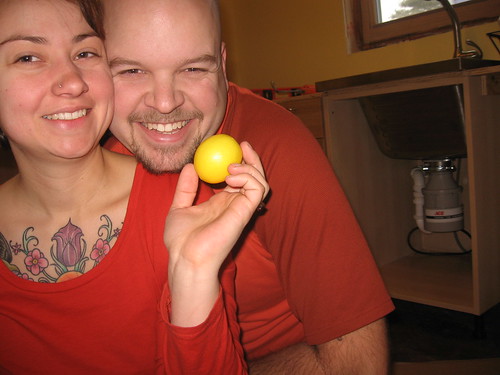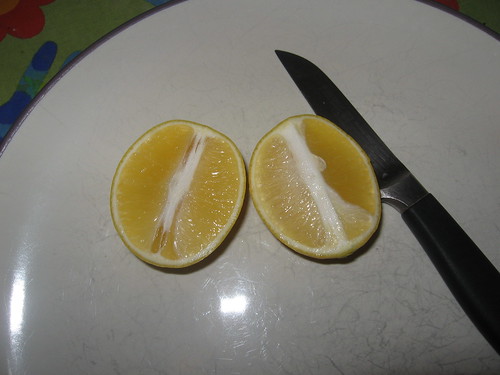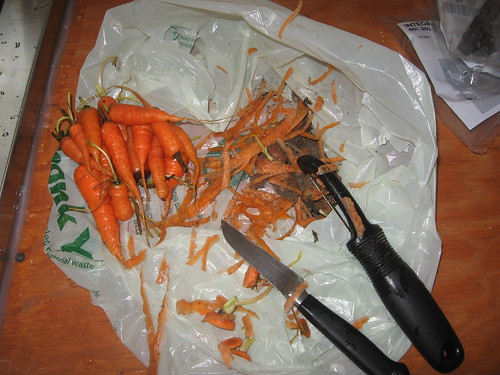To this point I haven't posted much on our kitchen/food blog. Rachel has been after me to remedy this oversight and now the Restaurant Widow has taken me to task over not posting about my meat CSA. First off, what is a CSA? If you are reading a food blog, I expect you know already. For those who do not know, CSA stands for Community Supported Agriculture. The basic concept is that at the start of the season you pay a local farmer or cooperative a certain amount of money (anywhere from $300-$600 is the usual price). In return, you receive farm products on a regular schedule. The products available are up to the farmer and usually reflect current production. Previously Rachel and I have participated in vegetable CSAs. It is quite fun and enjoyable to receive a surprise bag of vegetables, fruit, flour or honey on a weekly basis.
This fall I decided to try something new. 2Silos farm offered a meat CSA for the first time. 2silos supplies local grocery stores with a variety of organic, heirloom and free-range eggs. Their meat CSA started in November and is slated to run until April. So far I have received pork, beef, chicken, lamb, rabbit and a goose for Christmas. The pick-ups occur on the first Saturday of each month and I receive a bag of approximately 10 pounds of meat products.
Cuts have been quite varied. I have had london broil, flank steak, round steak (made into jerky below), NY Strip, ribeye, and ground chuck from the beef family. As far as pig products, I had so very nice tenderloin medallions, loin chops, and bulk breakfast sausage. Each month, I receive a whole frozen fryer and a dozen eggs. The lamb has been ground and also in packaged chops. I just cooked a whole fresh rabbit last week and it was delicious. I also apparently have game birds to look forward to in the next couple of months (quail, pheasant, etc...).

The goose I ordered for Christmas has been one of the highlights of the meat CSA. While not an included feature of the CSA, the Christmas Goose option was only an extra $25. For anyone who has ever bought goose, you will know they generally run about $30-$35 for a frozen goose. Prior to this goose I have never cooked a fresh goose. This was hands down the most delicious goose I have ever eaten. I put it in a simple brine and then used Julia Child's steam-roasting method to cook it. It was incredibly tender and everyone loved it at Christmas-eve dinner. I have to give credit to 2silos for raising a very flavorful bird.
I also receive odds and ends each month. So far I have found pig kidneys, pig liver and chicken liver in my grab bag. I am still trying to decide how to cook the pig offal, and will update when I do. The chicken liver and goose liver made an excellent stuffing for the Christmas goose.
Overall, I have really liked this meat CSA. Denise at 2silos has done a great job running it and communicating with the participants. We receive a monthly newsletter and Denise is quick at answering any questions. The meat has been of very high quality and of a nice diversity. I like being able to easily receive a more than generous quantity of meat each month that is raised by a local farmer. Since the CSA began I haven't had the need to purchase any meat from a grocery store.
The intangible benefit of CSA participation is that not only do you get really high-quality product on a regular basis, you support your local agricultural community. Many farmers are being forced out of business by large scale factory and commercial farming. To survive, farmers have turned to non-traditional methods to generate revenue. Some have explored niche markets like heirloom vegetables and animals. Others have gone the organic route. Establishing a CSA is a very good way for a farmer to make a guaranteed income over a season.
So take a look at the 2silos meat CSA. Denise is accepting applications now for the CSA that will run over the summer. And if meat isn't your thing, consider one of the many fine vegetable CSA's that are available in the Columbus area. Either way, you will love the diversity of food you receive, and you will have the satisfaction of supporting a farmer in your local community.










